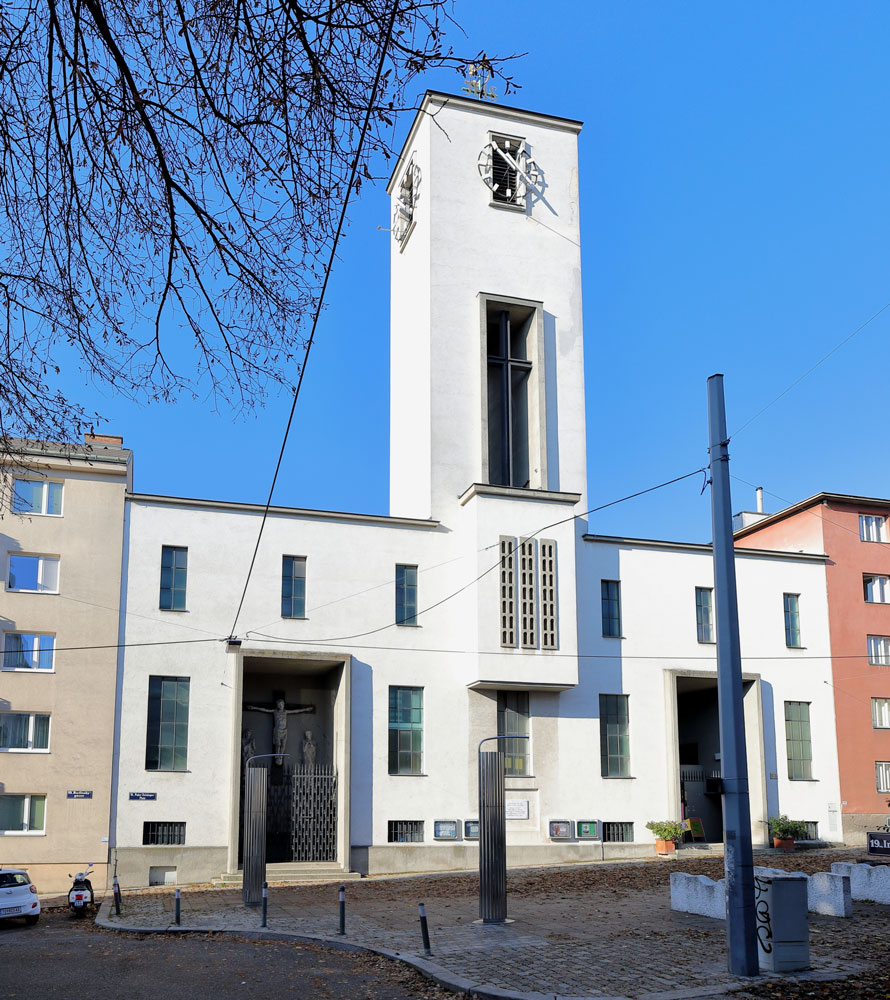
Clemens Holzmeister
Clemens Holzmeister was an Austrian architect, opera set designer and academic. He is credited for changing the face of operatic productions by turning not just the stage but the whole theatre into a set.
Perhaps Clemens Holzmeister’s most recognised achievement came in August 1933. The Weimar Republic’s most famous theatre and film producer Max Rheinhardt had commissioned him eight years earlier to create the Kleines Festspielhaus, the Small Festival Hall for the Salzburg Festival.

Funkhaus Wien, RadioKulture Haus Image 1
In 1933, his talent for fusing the macro details of architecture with the micro necessities of theatrical design came into its own when Rheinhardt – a Jew in the midst of being persecuted by the Nazi’s – tasked Holzmeister with the set design for a new production of Goethe’s Faust. Instead of refashioning the stage he created a whole town within the theatre, often described as ‘Faust City’. The stunning space is familiar to anyone who’s watched The Sound of Music, remember where the children perform at the Salzburg Festival? That’s the spot and its clearly not by chance that the ‘Uncle’ character is called Max.


Villa Runggaldier, Ortisei Italy 1926 Image 2 & 3
Holzmeister’s theatrical work did not get in the way of his drive to design large scale architecture. He won a competition to design the new Turkish Parliament and Government District in 1928. While work began in 1939 it was slowed down by World War II. It was ultimately completed in 1961 with other parliamentary buildings finished a few years later.
The Nazi party held no sympathy for him after he made his lack of affiliation clear. While he had been Director of the Austrian Academy of Fine Arts since 1931, Clemens Holzmeister’s tenure at Akademie der bildenden Künste Wien came to an abrupt end at the start of the Anschluss in March 1938. Ironically his design for the Funkhaus, Vienna’s House of Radio was claimed as a triumph of Fascist architecture.

Turkish Grand National Assembly TBMM 1938 -1960 Image 4

KrimKirche Vienna Image 5
The day his office at the Akademie was ransacked by local Nazi officials he was in Turkey. This led to a quarter century self-imposed exile when he worked on Turkish projects and became a Professor at the Istanbul Technical University Faculty of Architecture. He would not have been alone in Turkey, the German architects and urban planners Bruno Taut, Martin Elsaesser, Paul Bonatz, Gustav Oelsner, Ernst Reuter Hermann Jansen, Herman Erlgötz and Martin Wagner were also active in the country at the same time.

St Adalbert Berlin Mitte, Linienstrasse 101 Germany 1933 Image 6
Holzmeister formally returned to Austria in 1954, having accepted a commission to redesign the Großes Festspielhaus, the large theatre space at the Festival Theatre in Salzburg this time in Reinhardt’s absence.
Clemens Holzmeister’s story began in 1886 in Tyrol in the Austro Empire when it was at its height of grandeur. Though he had Brazilian citizenship that was by-the-by as he was for all intents and purposes Austrian. He achieved a Doctorate in Architecture at the TU Wein, the Vienna University of Technology where he became Head of Department of Architecture in 1924 and designed some 650 buildings.
His story ends when he died in 1983 and is buried in Petersfriedhof Salzburg. He left in his wake hundreds of sacred buildings, stage sets for the Salzburg Festival, Burghaus and Vienna State Opera. And, his work in Ankara still stands the test of time as to this day the President’s official home is a Holzmeister-designed building.
 Leopold Figl Warte Tyrol Image 7
Leopold Figl Warte Tyrol Image 7
 Leopold Figl Warte Image 8
Leopold Figl Warte Image 8
Awards
Grand Austrian State Prize for Architecture, Großer Österreichischer Staatspreis 1953
Honorary Ring of Vienna 1955
Österreichisches Ehrenzeichen für Wissenschaft und Kunst 1957
Cross of Merit with the Star Federal Republic of Germany 1959
Grand Decoration of Honour in Gold with Star for Services to the Republic of Austria, Ehrenzeichen fur Verdienste um die Republik Osterreich 1981
Order of Merit Republic of Turkey (posthumously) 1990

Red Vienna, Red Wein Ferdinand Blat Hof Residence Detail Image: Hafael CC BY SA 3.0
His achievements included:
Germany
Sacred: Eleven buildings including St Adalbert Berlin-Mitte 1933
Civil: Schlageter National Monument in Dusseldorf 1931
Austria
Sacred: Designed or renovated twenty-two churches in Austria
Civil: twenty-one buildings including the Salzburg Festspielhaus buildings (Holzmeister was to return to this project several times over the years in 1936-8 and in the 1950s) and the Leopold Figl Warte in Tulbingerkogel
Italy
Civil: six including Villa Runggaldier, Ortisei 1926
Turkey
Government Buildings: Ankara Government Officers Club 1933 Turkish Ministry of Defence 1928 Office of Turkish Commander in Chief 1930 Turkish Ministry of the Interior 1934 Turkish Central Banks national headquarters 1933 Turkish Court of Appeal Ankara 1934 Embassy of Austria in Turkey 1936 Turkish War Academy 1935 Çankaya Mansion, Official residence of the President 1932 Turkish Grand National Assembly TBMM 1938 -1960
Image (1) Tsui CC BY SA 3.0 Image (2)(3) Wolfgang Moroder CC BY SA 3.0 Image (4) CC BY SA 4.0 Makril © Image (5) © Bwag/CC-BY-SA-4.0. Image (6) Jorg Zagel CC BY SA 3.0 Image (7) © Bwag/CC-BY-SA-4.0 Image (8) © Bwag/CC-BY-SA-4.0 Image (9) Hafael CC BY SA 3.0
Shop Now: Greyscape Loves









